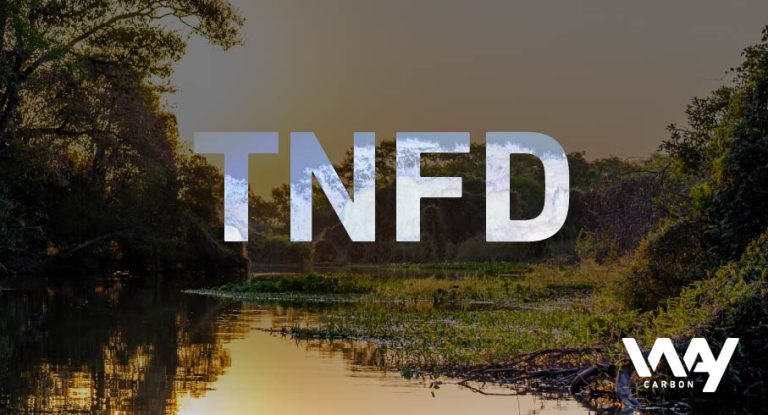Biodiversity and the TNFD: what do companies need to know?

Growing awareness of organizations’ climate change agendas and advances in strategies to reduce and mitigate greenhouse gas (GHG) emissions points to the urgent need to address the issue of biodiversity. This is an issue inextricably linked to climate but has not received the attention it deserves from the market until recently.
But what is biodiversity, after all?
The concept of biodiversity encompasses the different forms of life that exist on Earth at different scales, ranging from genetic diversity to species diversity, communities of organisms, and entire ecosystems. Biodiversity has co-evolved with ecosystems and contributes to the maintenance and diversity of many ecosystem services. These services are essential for human existence, as they include maintaining air, soil, and water quality, regulating the climate, preserving water cycles, pollination, pest control, and protection against natural phenomena, among many others.
The pressures caused by human activities have been increasing in frequency and magnitude, and ecosystems are unable to respond adequately. As a result, the scientific community believes that we are already experiencing the sixth mass extinction event of life on Earth. The so-called “biodiversity crisis”, together with the climate crisis, are two of the greatest challenges facing the planet today. One consequence of this crisis is the loss of nature’s ability to provide the ecosystem services on which we depend, including climate regulation. It is therefore vital to address these two crises in an integrated manner, by taking urgent action to conserve and restore nature and by promoting the adoption of sustainable practices in all sectors of society.
What does this have to do with the global economy?
In addition to its intrinsic value for life on the planet, biodiversity also has significant economic value. According to the World Economic Forum (2020), more than half of global output – some $44 trillion – depends on nature. However, ecosystem degradation is already causing losses of more than $5 trillion annually across all sectors. On the other hand, if we take positive action now to transform our environment, we can generate up to US$10.1 trillion annually in market value and create 395 million jobs by 2030 (HERWEIJER, 2020). Industries such as agriculture, forestry, fishing, tourism, cosmetics, and pharmaceuticals depend on the natural resources provided by ecosystems. Even industries that are not directly dependent on these resources are indirectly dependent through their production chains.
Biodiversity also plays a role in the development of new products and technologies, for example, through the research and inspiration found in living things to create systems and materials. The development of nature-based solutions (NBS) has demonstrated the financial benefits of investing in ecosystem integrity, saving resources through restoration and conservation measures, and ensuring the continuation of ecosystem services. NBS have already been used with great success around the world as multi-benefit climate adaptation measures. Examples of NBS applications include the protection and restoration of reefs and water sources, the conservation of rivers and springs, the establishment of agroforestry systems, and the creation and maintenance of urban green spaces.
By understanding how their activities affect ecosystems and biodiversity, companies can identify the environmental risks associated with their value chain and take steps to minimize them. On the other hand, they can better exploit the opportunities associated with the benefits of sustainable use of natural resources. The idea that an organization can impact the availability of a resource and at the same time be dependent on it constitutes the relationship conceptually known as “double materiality”. Understanding and strategically managing this relationship helps to ensure the sustainability of the business.
What is the role of the market in the quest for “no net loss” and “nature positive”?
As the urgency of addressing nature, biodiversity, and natural capital issues is recognised, the number of working groups, intergovernmental bodies, hubs, task forces, and initiatives for an economic transition to a lower-impact model is growing. This process begins with the reduction and mitigation of negative impacts, moves on to “no net loss”, which consists of neutralizing these impacts, and culminates in “nature positive”, where there is a positive impact on nature through the implementation of measures to conserve and restore ecosystems and increase their biodiversity.
In this context, national governments consolidated their commitments to biodiversity at the UN Biodiversity Conference – COP 15 in 2015 and 2022. This discussion resulted in the Kunming-Montreal Global Biodiversity Framework (GBF), with 23 action targets for 2030 and four major goals for 2050. Key targets include the conservation of 30% of the world’s ecosystems and the restoration of 30% of degraded ecosystems by 2030. It was agreed to mobilize US$200 billion for biodiversity, including transfers to countries in the Global South. These targets were formalized in GBF Target 19. GBF Target 15 calls on companies and financial institutions to monitor, assess, and report on their risks, dependencies, and impacts on nature, and to set concrete targets to improve their relationship with natural resources.
How can the TNFD drive the transition to a nature-positive economy?
The Taskforce on Nature-related Financial Disclosures (TNFD) is a working group of more than 40 members representing financial institutions, companies, and service providers. It was established in October 2021 to develop a framework for reporting on risks related to nature and natural capital, and to support the implementation of action plans that redirect global financial flows towards nature-positive operations and portfolios, essential actions to achieve Target 15. The first full version of the TNFD will be launched in September 2023, following feedback and refinement.
The TNFD stands out for offering a systematic methodological approach that enables organizations to measure, understand, and assess their relationship with nature. The methodology proposed by the framework consists of four main steps: identifying the organization’s or its portfolio’s interfaces with nature/natural capital; analyzing the dependencies and impacts in this relationship; assessing the associated risks and opportunities; and preparing to report the results of the assessment, and regularly reviewing and updating these results, including after the implementing of improvement measures. The TNFD methodology is aligned with the Science-Based Targets Network (SBTN) to facilitate organizational compliance and help establish a common standard among existing frameworks, including in parallel with the well-known Taskforce on Climate Related Financial Disclosures (TCFD).
As such, the TNFD plays an important role in the market by driving measures to achieve the GBF targets. The growing interest in biodiversity reporting reflects an understanding that developing strategies in this area is commercially advantageous for companies and financial institutions, both in terms of reducing exposure to nature-related risks and increasing organizational value through a robust ESG agenda.
How can WayCarbon help your organization stand out in this area?
WayCarbon provides a range of products and solutions to help drive the biodiversity agenda forward, making it a cross-cutting issue within the organization, in which it develops:
- Strategies for sustainable governance agendas and systems;
- Initial scopes in bioeconomy and application of the TNFD;
- Strategies and assessments of nature-based solutions and their co-benefits for biodiversity;
- Climate action plans, adaptation measures and spatial planning;
- Nature-based solutions projects, carbon capture, and the quality and stability of carbon projects.
References
Herweijer, C., et al. “Nature risk rising: Why the crisis engulfing nature matters for business and the economy.” World Economic Forum and PwC. https://www3.weforum.org/docs/WEF_New_Nature_Economy_Report_2020.pdf
 EN
EN  ES
ES PT
PT








